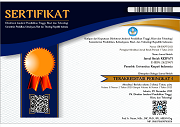Potensi Isolat Rhizobakteri Indigenous dari Rhizosfer Choy sum sebagai Agen Antagonis Phytophthora palmivora dan Colletotrichum gleoeosproioides
Abstract
Keywords
Full Text:
PDFReferences
E. Asare-Badiako, A. Addo-Quaye, B. Boakye, J.M. Sarbah, P. Asante, E. Dorm. Incidence and severity of viral and fungal diseases of chili pepper (Capsicum frutescens) in some districts in Ghana. Intl J Plant Soil Sci. 2015;1:147-59. DOI: 10.9734/IJPSS/2015/16830.
Nurbailis Y, Yanti Z, Resti A, Djamaan SD, Rahayu. Consortia of endophytic bacteria for controlling Colletotrichum gloeosporiodes causing anthracnose disease in chili plant. Biodiversitas. 2023;24(6):3503-11. DOI: 10.13057/biodiv/d240648.
D.D. De Silva, P.W. Crous, P.K. Ades, K.D. Hyde, P.W.J. Taylor. Lifestyles of Colletotrichum species and implications for plant biosecurity. Fungal Biol Rev. 2017;31: 155-168. DOI: 10.1016/j.fbr.2017.05.001.
U. Triasih, A.L. Abadi, A. Muhibbudin, S. Widyaningsih. Morphological and molecular identification as well pathogenicity of the causal agents of fruit rot disease of apple manalagi (Malus sylvestris) in Pujon, East Java. J Trop Plant Pests Dis. 2023;23(1):56-66. DOI: 10.23960/j.hptt.23156-66.
M. Kamle, P. Kumar. Colletotrichum gloeosporioides: Pathogen of anthracnose disease in mango (Mangifera indica L.) in Fungal Biology Current Trend in Plant Disease Diagnostic and Management. Switzerland: Springer International Publishing, 2016; p. 207-19. DOI: 10.1007/978-3-319-27312-9_9.
B. Vanegtern, M. Rogers, S. Nelson. Black pod rot of cacao caused by Phytophthora palmivora. Plant Dis. 2015;108. www.ctahr.hawaii.edu/oc/freepubs/pdf/PD-108.pdf.
D. Adeniyi. Diversity of cacao pathogens and impact on yield and global production. Chapter 3, in Theobroma cacao deploying science for sustainability of global cocoa economy. United Kingdom London: Intechopen, 2019; p. 164. www.intechopen.com/books/7005. DOI: 10.5772/intechopen.73761.
B.A. Khan, M.A. Nadeem, H. Nawaz, M.M. Amin, G.H. Abbasi, M. Nadeem, M. Ali, M. Ameen, M.M. Javaid, R. Magbool, M. Ikram, M.A. Ayub. Pesticides: Impacts on agriculture productivity, environment, and management strategies. in Emerging Contaminants and Plants. Switzerland AG: Springer Nature, 2023; p. 109-33.
M.T. El-Saadony, A.M. Saad, S.M. Soliman, H.M. Salem, A.I. Ahmed, M. Mahmood, A.M. El-Tahan, A.A.M. Ebrahim, T.A.A. El-Mageed, S.H. Negm, S. Selim, A.O. Babalghith, A.S. Elrys, K.A. El-Tarabily, S.F. AbuQamar. Plant growth-promoting microorganisms as biocontrol agents of plant diseases: mechanisms, challenges and future perspectives. Front Plant Sci. 2022;3(923880):1-19. DOI: 10.3389/fpls.2022.923880.
H.A. Pantigoso, D. Newberger, J.M. Vivanco. The rhizosphere microbiome: Plant–microbial interactions for resource acquisition. J Appl Microbiol. 2020;133(5): 2864–76. DOI: 10.1111/jam.15686.
E.B. Felestrino, I.T. Vieira, W.L. Caneschi, I.F. Cordeiro, R.A.B. Assis, C.G.C. Lemes, N.P. Fonseca, A.B. Sanchez, J.C.C. Cepeda, J.A. Ferro, C.C.M. Garcia, F.F. do Carmo, L.H.Y. Kamino, L.M. Moreira. Biotechnological potential of plant growth-promoting bacteria from the roots and rhizospheres of endemic plants in ironstone vegetation in southeastern Brazil. World J Microb Biot. 2018;34(156):1-14. DOI: 10.1007/s11274-018-2538-0.
S. Larbi-Koranteng, R.T. Awuah, F. Kankam. Biological control of black pod disease of cocoa (Theobroma cacao L.) with Bacillus amyloliquefaciens, Aspergillus sp., and Penicillium sp. in vitro and in the field. Journal of Microbiology and Antimicrobials. 2020;12(2):52-63. DOI: 10.5897/JMA2020.0434.
S.W. Pratama, S. Sukamto, I.N. Asyiah, Y.V. Ervina. Growth inhibition of cocoa pod rot fungus Phytophthora palmivora by Pseudomonas fluorescence and Bacillus subtilis bacteria. Pelita Perkebunan. 2013;29(2):120-27. DOI: 10.22302/iccri.jur.pelitaperkebunan.v29i2.59.
R. Thilagam, N. Hemalatha. Plant growth promotion and chilli anthracnose disease suppression ability of rhizosphere soil actinobacteria. J Appl Microbiol. 2019;126(6):1835-49. DOI: 10.1111/jam.14259.
U. Conrath, G.J.M. Beckers, C.J.G. Langenbach, M.R. Jaskiewicz. Priming for enhanced defense. Annu Rev Phytopathol. 2015;53:97–119. DOI: 10. 1146/annurev-phyto-080614-120132.
N. Xiang, K.S. Lawrence, P.A. Donald. Biological control potential of plant growth-promoting rhizobacteria suppression of Meloidogyne incognita on cotton and Heterodera glycines on soybean: A review. J Phytopathol. 2018;166:449-458. DOI: 10.1111/jph.12712.
J. Kohl, R. Kolnaar, W.J. Ravensberg. Mode of action of microbial biological control agents against plant diseases: relevance beyond efficacy. Front Plant Sci. 2019;10:845. DOI: 10.3389/fpls.2019.00845.
Babbal, Advitiya, Y.P Khasa. 2017. Microbes as biocontrol agents in Probiotics and Plant Health. Singapore Pte Ltd: Springer Nature, 2017; p. 507-522. DOI: 10.1007/978-981-10-3473-2_24.
S.S.K.P. Vurukonda, D. Giovanardi, E. Stefani. Plant growth promoting and biocontrol activity of Streptomyces spp. as endophytes. Int. J Mol Sci. 2018;19(952):1-26. DOI: 10.3390/ijms19040952.
B. Khameneh, M. Iranshahy, V. Soheili, and B.S.F. Bazzaz. Review on Plant Antimicrobials: A Mechanistic Viewpoint. Antimicrobial Resistance and Infection Control. Antimicrobial Resistance and Infection Control. 2019;8(118):1-28.
E. Etebu, I. Arikekpar. Antibiotics: Classification and mechanisms of action with emphasis on molecular perspectives. Int J Appl Microbiol Biotechnol. Res. 2016;4:90-101.
D. Zhang, R. Qiang, Z. Zhou, Y. Pan, S. Yu, W. Yuan, J. Cheng, J. Wang, D. Zhao, J. Zhu, Z. Yang. Biocontrol and action mechanism of Bacillus subtilis lipopeptides’ fengycins against Alternaria solani in potato as assessed by a transcriptome analysis. Front Microbiol. 2022;13(861113):1-18. DOI: 10.3389/fmicb.2022.861113.
W.J. Van Jaarsveld, F. Halleen, L. Mostert. In vitro screening of Trichoderma isolates for biocontrol of black foot disease pathogens. Phytopathol Mediterr. 2020;59(3):465-471. DOI: 10.14601/Phyto-11173.
E.H. Pudjiwati, R. Rindiani. Prospek rizobakteri penghasil indole butyric acid (IAA) dan penyedia nitrat sebagai plant growth-promoting rhizobacteria (PGPR). J-PEN Borneo: Jurnal Ilmu Pertanian. 2022;5(1). E-ISSN: 2599-2872, P-ISSN: 2549-8150.
E.H. Pudjiwati, Amarullah, S. Mukrimah. Mewujudkan komitmen pengelolaan kekayaan potensi lokal di wilayah perbatasan. Prosiding Seminar Nasional Humaniora dan Saintek II; 2019.
D.A. Al Maliki. Seleksi rhizobakteri sebagai agens pemacu pertumbuhan tanaman jagung (Zea mays L.) [Sarjana Skripsi]. Kalimantan Utara: Universitas Borneo Tarakan; 2019.
Muzakir, Hifnalisa, J. Jauharlina, R. Sriwati. Antagonistic screening of Trichoderma spp. isolated from patchouli rhizosphere. IOP Conf. Series: Earth and Environmental Science. 2024; 951 (012021): 1-6. DOII:10.1088/1755-1315/951/1/012021.
A.O.A. Osman, I.S. Mohamed. Antifungal evaluation of leaf extracts and fungicide against Fusarium oxysporum f.sp. lycopersici causal agent wilt of tomato. Bioteknologi. 2017;14(1). DOI: 10.13057/biotek/c140101.
E.H. Pudjiwati, S. Zahara, D. Sartika. Isolasi dan karakterisasi rhizobakteri yang berpotensi sebagai agen pemacu pertumbuhan tanaman. Jurnal Borneo Saintek. 2019;2(2). E-ISSN 2599-3313, P-ISSN 2615-434X.
H. Lorck. Production of hiydrocyanic acid by bacteria. Physiology plant, 1: 142-146.
R.J. Kremer, S. Thouraya. Cyianide Production by rhizobacteria and potential for suppression of weed seedling growth. Current Microbiology. 2001;43:182-86.
A.W. Bekker, B. Schippers. Microbial cyanide relation to potato yield reduction and Pseudomonas spp.- mediated plant growth- stimulation. Soil Biol. Biochem. 1987;19:249-256.
A. Munif. Studies on the Importance of Endophytic Bacteria for the Biological Control of the Root-Knot Nematode Meloidogyne incognita on Tomato [Dissertation Doktor]. German: Freiderich-Wilhelrms-Universitat Bonn; 2001.
V.T. Tran, H.T. Nguyen, H.T. Nguyen, D.D. Le. Isolation and characteristics of Pseudomonas fluorescens to inhibit Phytophthora palmivora causing rot disease in durian. The Journal of Agriculture and Development. 2023;22(3):31-38. DOI: 10.52997/jad.4.03.2023.
D. Majumder, J.D. Kongbrailatpam, E.G. Suting, B. Kangjam, D. Lyngdoh. Pseudomonas fluorescens: A potential biocontrol agent for management of fungal diseases of crop plants. in Future Challenges in Crop Production Against Fungal Pathogens. Springer Nature, 2014; p. 317-342. DOI: 10.1007/978-1-4939-1188-2_11.
J. Mishra, N.K. Aror. Secondary metabolites of fluorescent pseudomonads in biocontrol of phytopathogens for sustainable agriculture. App Soil Ecol. 2018;125:35-45. DOI: 10.1016/j.apsoil.2017.12.004.
L. Zhang, M. Yan, Y. Ren, Y. Chen, S. Zhang. Zinc regulates the hydraulic response of maize root under water stress conditions. Plant Physiol Biochem. 2021;159:123-134. DOI: 10.1016/j.plaphy.2020.1.
A.A. El-Shahir, D.A. El-Wakil, A.A.H.A. Latef, N.H. Yousef. Bioactive compounds and antifungal activity of leaves and fruits methanolic extracts of Ziziphus spina-christi L. Plants (Basel). 2022;11(6):746. DOI: 10.3390/plants11060746.
A. Sehrawat, S.S. Sindhu, B.R. Glick. Hydrogen cyanide production by soil bacteria: Biological control of pests and promotion of plant growth in sustainable agriculture. Pedosphere. 2022;32(1):15-38. DOI: 10.1016/S1002-0160(21)60058-9.
T. Rijavec, A Lapanje. Hydrogen cyanide in the rhizosphere: Not suppressing plant pathogens, but rather regulating availability of phosphate. Front Microbiol. 2016:7(1785). DOI: 10.3389/fmicb.2016.01785.
B. Prapagdee, C. Kuekulvog, S. Mongkulsuk. Antifungal potensial of extracellular metabolites produce by Streptomyces hygrospicus against phytophstogenic fungi. International Journal of Biological Science. 2008;4(5):330-37.
A.K. Singh, H.S. Chhatpar. Purification and characterization of chitinase from Paenibacillus sp. D1. Appl Biochem Biotechnol. 2011;164(1):77-88. DOI: 10.1007/s12010-010-9116-8
M. Imbert, M. Bechet, R. Blondeau. Comparison of the main siderophores produced by some species of Streptomyces. Curr Microbiol. 1995;31: 129-133. DOI: 10.1007/BF00294289.
D. Macagnan, R.S. Romeiro, A.W.V. Pomella, J.T. de Souza. Production of lytic enzymes and siderophores, and inhibition of germination of basidiospores of Maniliopthora (ex Crinipellis) perniciosa by phylloplane actinomycetes. J Biol Control. 2008;47:309-14. DOI: 10.1016/j.biocontrol.2008.08.016.
I. Dimkić, T. Janakiev, M. Petrović, G. Degrassi, D. Fira. Plant-associated Bacillus and Pseudomonas antimicrobial activities in plant disease suppression via biological control mechanisms - A review. Physiol Mol Plant Pathology. 2022;117(101754). DOI: 10.1016/j.pmpp.2021.101754.
W. Firdausi, L. Sulistyowati, L.Q. Aini. Exploration and antifungal assay of endophytic fungi as biocontrol of onion purple blotch disease caused by Alternaria porri (Ell) Cif in vitro. AGRIVITA, J Agr Sci. 2021;43(1):114-124. DOI: 10.17503/agrivita.v43i1.2838.
A. Sharma, S.K. Arya, J. Singh, B Kapoor, JS Bahtti, A Suttee, G. Singh. Prospects of chitinase in sustainable farming and modern biotechnology: an update on recent progress and challenges. Biotechnol Genet Eng. 2023;1:1-31. DOI: 10.1080/02648725.2023.2183593.
Y.Y. Chen, P.C. Chen, T.T. Tsay. The biocontrol efficacy and antibiotic activity of Streptomyces plicatus on the oomycete Phytopthora capsica. Journal Bological Control. 2016;2(11): 1-27. DOI: 10.1016/j.biocontrol.2016.02.011.
DOI: https://doi.org/10.52643/jir.v16i2.5210
Refbacks
- There are currently no refbacks.
Copyright (c) 2025 Eko Hary Pudjiwati, Siti Zahara, Rani Saffera, Risnawati Risnawati













